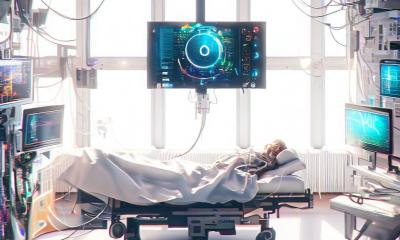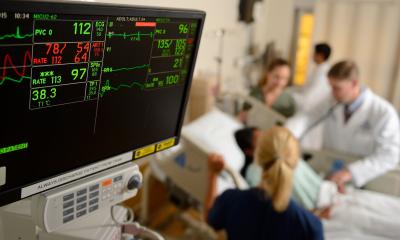News • Decision support
AI can predict septic shock
Researchers at Linköping University (LiU) have developed an algorithm that can identify patients at a higher risk of septic shock, a life-threatening condition that is difficult for doctors to predict.
At the same time, it is important to recognise the symptoms as early as possible, since early treatment increases the chance of survival. A group of LiU researchers is using artificial intelligence to identify patients at the highest risk of being affected. “We have developed an algorithm that can identify patients at a higher risk of septic shock”, says Magnus Bång, senior lecturer in the Department of Computer and Information Science, IDA.

Image source: LiU/Emma Busk Winquist
He leads a research project in which Linköping University collaborates with Linköping University Hospital and Region Östergötland. The project also includes Michelle Chew, physician and professor at Linköping University, and Daniel Wilhelms, also a physician and LiU researcher. “We are working on the algorithm, and we are testing AI technology in medical care”, says Magnus Bång.
Josef Fagerström, doctoral student at IDA, is a member of the research group and has just published an article describing the algorithm in the journal Scientific Reports. “The algorithm is in machine learning. We have trained a large neural network using data from MIMIC, an American database that contains large amounts of biometric data and laboratory results from a hospital in Boston”, says Josef Fagerström.
We humans find it extremely difficult to see the pattern. The algorithm considers not only a large number of parameters, but also the relationships between them
Josef Fagerström
MIMIC holds information from 59,000 admissions to an intensive care ward. It contains, for example, the patient’s age, weight, blood pressure, pulse rate and respiration frequency, together with laboratory results, the patient’s history, and information about previous procedures.
Allowing the network to investigate information in the database may allow it to find connections between certain observations and septic shock. “We know what the patient data look like after septic shock has occurred. We used the medical literature to select around 30 parameters, such as body temperature, pulse, age, previous conditions, etc. Then we ran a training algorithm on the neural network. It learnt to identify patients who subsequently suffered septic shock. The algorithm can thus identify, with relatively high precision, patients before they develop septic shock”, says Josef Fagerström.
The pattern that the algorithm finds is so complicated that a human cannot understand how it arose. “We humans find it extremely difficult to see the pattern. The algorithm considers not only a large number of parameters, but also the relationships between them. These are also very complex”, says Josef Fagerström.
Magnus Bång’s research group has also built an AI system for patient monitoring. The intention is to use the technology in the future to monitor patients in hospital in real time. “We have a vision of being able to watch over all patients. If we take septic shock as an example, we collect all the measured values and allow the network to analyse them. When it detects someone at risk of developing septic shock, it informs the doctor”, says Magnus Bång.
So how is the doctor to use this information? “Exactly what happens is a question to be discussed later, but the information can support doctors in their decision making. When the algorithm detects something, the doctor is informed about it. But it’s the doctor who takes all the decisions. At the moment, we are only testing the technology to see that it works”, says Magnus Bång.
Recommended article

News • 1 in 5
Sepsis death toll twice as high as assumed
Twice as many people as previously believed are dying of sepsis worldwide, according to an analysis published in The Lancet and announced at the Critical Care Reviews annual meeting in Belfast. Among them are a disproportionately high number of children in poor areas.
Magnus Bång says that the combination of artificial intelligence, big data and medical care is a hot research area at the moment. And as always in the field of medicine, the research is surrounded by many safety regulations. “The work is subject to ethical vetting, when testing the technology on patients. Our AI system, however, if we are allowed to test it, will not be used for patient diagnosis. Initially, we are only interested in technical testing”, says Magnus Bång.
He compares the process with that of developing a new drug. “You have to carry out a controlled trial. Only if a drug works can you start to use it, but before then it must undergo rigorous testing.” He believes that they will soon be able to test the project. “We hope to be able to test our system at the A&E Department at Linköping University Hospital during 2020”, says Magnus Bång.
Source: Linköping University
27.01.2020










